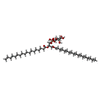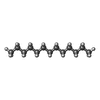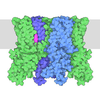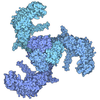[English] 日本語
 Yorodumi
Yorodumi- PDB-9p6b: Cryo-EM structure of full-length human TRPV1 in the presence of a... -
+ Open data
Open data
- Basic information
Basic information
| Entry | Database: PDB / ID: 9p6b | |||||||||||||||
|---|---|---|---|---|---|---|---|---|---|---|---|---|---|---|---|---|
| Title | Cryo-EM structure of full-length human TRPV1 in the presence of alpha-humulene | |||||||||||||||
 Components Components | Transient receptor potential cation channel subfamily V member 1 | |||||||||||||||
 Keywords Keywords | MEMBRANE PROTEIN / transient receptor potential V family member 1 / TRP / channel / TRPV1 / TRP channels / sesquiterpene / alpha-humulene / pain / analgesia | |||||||||||||||
| Function / homology |  Function and homology information Function and homology informationchemosensory behavior / response to capsazepine / sensory perception of mechanical stimulus / peptide secretion / excitatory extracellular ligand-gated monoatomic ion channel activity / temperature-gated ion channel activity / detection of chemical stimulus involved in sensory perception of pain / smooth muscle contraction involved in micturition / fever generation / detection of temperature stimulus involved in thermoception ...chemosensory behavior / response to capsazepine / sensory perception of mechanical stimulus / peptide secretion / excitatory extracellular ligand-gated monoatomic ion channel activity / temperature-gated ion channel activity / detection of chemical stimulus involved in sensory perception of pain / smooth muscle contraction involved in micturition / fever generation / detection of temperature stimulus involved in thermoception / thermoception / cellular response to acidic pH / dendritic spine membrane / TRP channels / diet induced thermogenesis / cellular response to alkaloid / cellular response to ATP / detection of temperature stimulus involved in sensory perception of pain / intracellularly gated calcium channel activity / behavioral response to pain / calcium ion import across plasma membrane / voltage-gated calcium channel activity / extracellular ligand-gated monoatomic ion channel activity / phosphatidylinositol binding / phosphoprotein binding / GABA-ergic synapse / calcium ion transmembrane transport / calcium channel activity / lipid metabolic process / transmembrane signaling receptor activity / sensory perception of taste / cellular response to heat / protein homotetramerization / postsynaptic membrane / calmodulin binding / cell surface receptor signaling pathway / negative regulation of transcription by RNA polymerase II / ATP binding / metal ion binding / membrane / plasma membrane Similarity search - Function | |||||||||||||||
| Biological species |  Homo sapiens (human) Homo sapiens (human) | |||||||||||||||
| Method | ELECTRON MICROSCOPY / single particle reconstruction / cryo EM / Resolution: 2.74 Å | |||||||||||||||
 Authors Authors | Talyzina, I.A. / Sobolevsky, A.I. | |||||||||||||||
| Funding support |  United States, 4items United States, 4items
| |||||||||||||||
 Citation Citation |  Journal: Proc Natl Acad Sci U S A / Year: 2025 Journal: Proc Natl Acad Sci U S A / Year: 2025Title: Structural basis of the inhibition of TRPV1 by analgesic sesquiterpenes. Authors: Raúl Sánchez-Hernández / Miguel Benítez-Angeles / Irina A Talyzina / Itzel Llorente / Mariela González-Avendaño / Félix Sierra / Angélica Méndez-Reséndiz / Francisco Mercado / ...Authors: Raúl Sánchez-Hernández / Miguel Benítez-Angeles / Irina A Talyzina / Itzel Llorente / Mariela González-Avendaño / Félix Sierra / Angélica Méndez-Reséndiz / Francisco Mercado / Ariela Vergara-Jaque / Alexander I Sobolevsky / León D Islas / Tamara Rosenbaum /    Abstract: The Transient Receptor Potential Vanilloid 1 (TRPV1) ion channel is expressed in primary nociceptive afferents, which participate in processes such as pain and inflammation. Considerable efforts have ...The Transient Receptor Potential Vanilloid 1 (TRPV1) ion channel is expressed in primary nociceptive afferents, which participate in processes such as pain and inflammation. Considerable efforts have been directed toward finding inhibitors of TRPV1 and understanding the molecular details of their interactions with this channel. α-humulene (AH) is a sesquiterpene derived from plants such as hops and other members of Cannabaceae family, with a long history of popular use as an analgesic and anti-inflammatory. Using a combination of behavioral assays, electrophysiology, site-directed mutagenesis, cryo-EM, and molecular dynamics simulations, we show that AH inhibits TRPV1-related pain responses and currents by interacting with a region composed of the S2, S2-S3 linker, and S3 transmembrane segments and stabilizing the closed conformation of the channel. The interaction of ligands in this region of the TRPV1 channel has not been previously described and the results of the present study highlight that it may constitute part of a negative regulatory region. These findings allow us to understand the molecular basis by which substances such as some sesquiterpenes, abundantly found in medicinal plants used by humans for hundreds of years, reduce pain. Pain management can include the use of opioids, which results in hepatic and renal damage and possible addiction. Our study offers insight into a poorly understood group of compounds that could be used as scaffold to produce novel nonopioid analgesic therapies and clarifies the molecular mechanisms that underlie the effects of these analgesic molecules. | |||||||||||||||
| History |
|
- Structure visualization
Structure visualization
| Structure viewer | Molecule:  Molmil Molmil Jmol/JSmol Jmol/JSmol |
|---|
- Downloads & links
Downloads & links
- Download
Download
| PDBx/mmCIF format |  9p6b.cif.gz 9p6b.cif.gz | 543.3 KB | Display |  PDBx/mmCIF format PDBx/mmCIF format |
|---|---|---|---|---|
| PDB format |  pdb9p6b.ent.gz pdb9p6b.ent.gz | 427.7 KB | Display |  PDB format PDB format |
| PDBx/mmJSON format |  9p6b.json.gz 9p6b.json.gz | Tree view |  PDBx/mmJSON format PDBx/mmJSON format | |
| Others |  Other downloads Other downloads |
-Validation report
| Summary document |  9p6b_validation.pdf.gz 9p6b_validation.pdf.gz | 2 MB | Display |  wwPDB validaton report wwPDB validaton report |
|---|---|---|---|---|
| Full document |  9p6b_full_validation.pdf.gz 9p6b_full_validation.pdf.gz | 2.1 MB | Display | |
| Data in XML |  9p6b_validation.xml.gz 9p6b_validation.xml.gz | 105.6 KB | Display | |
| Data in CIF |  9p6b_validation.cif.gz 9p6b_validation.cif.gz | 147 KB | Display | |
| Arichive directory |  https://data.pdbj.org/pub/pdb/validation_reports/p6/9p6b https://data.pdbj.org/pub/pdb/validation_reports/p6/9p6b ftp://data.pdbj.org/pub/pdb/validation_reports/p6/9p6b ftp://data.pdbj.org/pub/pdb/validation_reports/p6/9p6b | HTTPS FTP |
-Related structure data
| Related structure data |  71303MC M: map data used to model this data C: citing same article ( |
|---|---|
| Similar structure data | Similarity search - Function & homology  F&H Search F&H Search |
- Links
Links
- Assembly
Assembly
| Deposited unit | 
|
|---|---|
| 1 |
|
- Components
Components
-Protein , 1 types, 4 molecules ABCD
| #1: Protein | Mass: 124575.281 Da / Num. of mol.: 4 Source method: isolated from a genetically manipulated source Source: (gene. exp.)  Homo sapiens (human) / Gene: TRPV1, VR1 / Cell line (production host): HEK293S / Production host: Homo sapiens (human) / Gene: TRPV1, VR1 / Cell line (production host): HEK293S / Production host:  Homo sapiens (human) / References: UniProt: Q8NER1 Homo sapiens (human) / References: UniProt: Q8NER1 |
|---|
-Non-polymers , 5 types, 134 molecules 








| #2: Chemical | ChemComp-POV / ( #3: Chemical | ChemComp-8IJ / ( #4: Chemical | ChemComp-TRD / #5: Chemical | #6: Water | ChemComp-HOH / | |
|---|
-Details
| Has ligand of interest | N |
|---|---|
| Has protein modification | N |
-Experimental details
-Experiment
| Experiment | Method: ELECTRON MICROSCOPY |
|---|---|
| EM experiment | Aggregation state: PARTICLE / 3D reconstruction method: single particle reconstruction |
- Sample preparation
Sample preparation
| Component | Name: full-length human TRPV1 in the presence of alpha-humulene Type: COMPLEX / Entity ID: #1 / Source: RECOMBINANT | ||||||||||||||||||||
|---|---|---|---|---|---|---|---|---|---|---|---|---|---|---|---|---|---|---|---|---|---|
| Molecular weight | Value: 0.50 MDa / Experimental value: NO | ||||||||||||||||||||
| Source (natural) | Organism:  Homo sapiens (human) Homo sapiens (human) | ||||||||||||||||||||
| Source (recombinant) | Organism:  Homo sapiens (human) / Cell: Human embryonic kidney 293 / Plasmid: pEG BacMam Homo sapiens (human) / Cell: Human embryonic kidney 293 / Plasmid: pEG BacMam | ||||||||||||||||||||
| Buffer solution | pH: 7 | ||||||||||||||||||||
| Buffer component |
| ||||||||||||||||||||
| Specimen | Conc.: 2.4 mg/ml / Embedding applied: NO / Shadowing applied: NO / Staining applied: NO / Vitrification applied: YES / Details: human TRPV1 | ||||||||||||||||||||
| Specimen support | Grid material: GOLD / Grid mesh size: 300 divisions/in. / Grid type: UltrAuFoil R1.2/1.3 | ||||||||||||||||||||
| Vitrification | Instrument: FEI VITROBOT MARK IV / Cryogen name: ETHANE / Humidity: 100 % / Chamber temperature: 295 K |
- Electron microscopy imaging
Electron microscopy imaging
| Experimental equipment |  Model: Titan Krios / Image courtesy: FEI Company |
|---|---|
| Microscopy | Model: TFS KRIOS |
| Electron gun | Electron source:  FIELD EMISSION GUN / Accelerating voltage: 300 kV / Illumination mode: FLOOD BEAM FIELD EMISSION GUN / Accelerating voltage: 300 kV / Illumination mode: FLOOD BEAM |
| Electron lens | Mode: BRIGHT FIELD / Nominal defocus max: 2200 nm / Nominal defocus min: 700 nm / Cs: 2.7 mm |
| Image recording | Average exposure time: 1.318 sec. / Electron dose: 50 e/Å2 / Film or detector model: GATAN K3 (6k x 4k) / Num. of grids imaged: 1 / Num. of real images: 9208 |
| Image scans | Width: 5760 / Height: 4092 |
- Processing
Processing
| EM software |
| ||||||||||||||||||||||||||||||||
|---|---|---|---|---|---|---|---|---|---|---|---|---|---|---|---|---|---|---|---|---|---|---|---|---|---|---|---|---|---|---|---|---|---|
| CTF correction | Type: PHASE FLIPPING AND AMPLITUDE CORRECTION | ||||||||||||||||||||||||||||||||
| Particle selection | Num. of particles selected: 1693063 | ||||||||||||||||||||||||||||||||
| Symmetry | Point symmetry: C4 (4 fold cyclic) | ||||||||||||||||||||||||||||||||
| 3D reconstruction | Resolution: 2.74 Å / Resolution method: FSC 0.143 CUT-OFF / Num. of particles: 226949 / Symmetry type: POINT | ||||||||||||||||||||||||||||||||
| Atomic model building | Space: REAL | ||||||||||||||||||||||||||||||||
| Refinement | Stereochemistry target values: REAL-SPACE (WEIGHTED MAP SUM AT ATOM CENTERS) | ||||||||||||||||||||||||||||||||
| Refine LS restraints |
|
 Movie
Movie Controller
Controller


 PDBj
PDBj





